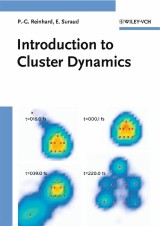Details

Introduction to Cluster Dynamics
1. Aufl.
|
171,99 € |
|
| Verlag: | Wiley-VCH |
| Format: | |
| Veröffentl.: | 11.07.2008 |
| ISBN/EAN: | 9783527621019 |
| Sprache: | englisch |
| Anzahl Seiten: | 341 |
DRM-geschütztes eBook, Sie benötigen z.B. Adobe Digital Editions und eine Adobe ID zum Lesen.
Beschreibungen
Clusters as mesoscopic particles represent an intermediate state of matter between single atoms and solid material. The tendency to miniaturise technical objects requires knowledge about systems which contain a "small" number of atoms or molecules only. This is all the more true for dynamical aspects, particularly in relation to the qick development of laser technology and femtosecond spectroscopy. <br> Here, for the first time is a highly qualitative introduction to cluster physics. With its emphasis on cluster dynamics, this will be vital to everyone involved in this interdisciplinary subject. The authors cover the dynamics of clusters on a broad level, including recent developments of femtosecond laser spectroscopy on the one hand and time-dependent density functional theory calculations on the other.
1. Basic features<br> 2. Experimental access<br> 3. Theoretical description<br> 4. Gross properties and trends<br> 5. More on Dynamics in the non-linear regime<br> 6. Conclusion<br> 7. Appendices
"...the book can be recommended for all beginners and researchers in the world of clusters and their dynamics, as an excellent combination of smooth entry and broad overview."<br> Bernd Hartke, Institut fur Physikalische Chemie, Universitat Kiel<br> Angewandte Chemie + IE 2004 - 116 / 24<br> <br> <br> "A competent concept combined with an interesting style and numerous helpful figures makes this book a pleasure to read. ... "Introduction to Cluster Dynamics" has certainly the potential to become a classical source for the education of graduate and PhD students providing teachers with a consistent and compact curriculum as well as giving the freshmen a quick access to the basic ideas and relevant literature."<br> Dr. Michael Moseler, Fraunhofer Institut fur Werkstoffmechanik, Freiburg, ChemPhysChem, 2004<br> <br>
<b>Paul-Gerhard Reinhard</b> has been professor for Theoretical Physics at the Friedrich-Alexander university Erlangen/Nürnberg since 1983. He received his PhD in 1970 at the Johann-Wolfgang-Goethe university Frankfurt. His post-doctoral studies brought him to Erlangen, Oxford, and Mainz. He obtained his Habilitation in 1977 at the Johannes-Gutenberg university in Mainz. He was fellow of the Heisenberg program in the years 1978-1983. His present research interests cover cluster physics, nuclear structure physics and plasma physics. <p><b>Eric Suraud</b> has been professor for Theoretical Physics at the Paul-Sabatier university in Toulouse, France, since 1992. He received his PhD in 1984 at the Paris university and his Habilitation in 1989 at the Grenoble university. He was junior member of Institut Universitaire de France in 1994-1999. He is presently director of the Institute de Recherche sur les Systemes Atomiques et Moleculaires Complexes in Toulouse and Vice Director of Institut de Physique Nucléaire et des Particules at CNRS in Paris. His present research interests mostly cover cluster physics and nuclear dynamics.</p> <p> </p>
<b>C</b>lusters as mesoscopic particles represent an intermediate state of matter between single atoms and solid materials. The tendency to miniaturise technical objects requires knowledge about systems which contain a “small” number of atoms or molecules only. This is all the more true for dynamical aspects, particularly in relation to the quick development of laser technology and femtosecond spectroscopy. <p>Here, for the first time is a highly qualitative introduction to cluster physics. With its emphasis on cluster dynamics, this will be vital to everyone involved in this interdisciplinary subject. The authors cover the dynamics of clusters on a broad level, including recent developments of femtosecond laser spectroscopy on the one hand and time-dependent density functional theory calculations on the other.</p> <p> </p>
Diese Produkte könnten Sie auch interessieren:

Introduction to Focused Ion Beams

von: Lucille A. Giannuzzi, Lucille A. North Carolina State University

128,39 €















